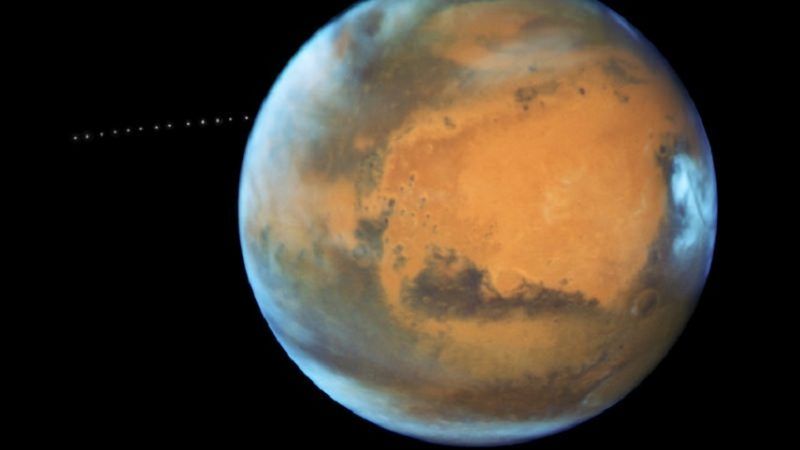The Planetary Protection Racket
It isn't just another useless, overpaid bureaucrat, but a crippler to any mission to Mars.

The request by NASA for a new "Planetary Protection Officer" salaried at $187,000 per year has provoked some hilarity, but the problem is much greater than the hiring of another useless overpaid bureaucrat. In fact, NASA's planetary protection program serves no function but to cripple the space program at a cost to the taxpayers of billions of dollars.
The program calls for protecting Mars and Earth from "contaminating" each other, but there is not one shred of evidence to support the notion that life of any kind, let alone pathogens of macrofauna or macroflora, or free-living microbes with superior adaptation to the terrestrial environment than native species, exists on the Martian surface.
The Viking 1 and 2 landers directly tested Martian soil, and found it free of organic material down to one part per billion accuracy. The Martian dust is mixed on a global basis. If there is no organic material in the dust at the Viking landing sites, there is none in it anywhere. The Viking landers also detected strong oxidizing agents in the Martian dust, which would destroy any microbes exposed to it. So we not only know that the Martian soil is sterile, we also know why it must be sterile. Even in the absence of the sterilizing oxidizers detected by Viking, conditions on the Martian surface are such so as to preclude active microbial metabolism. Active life cannot exist without liquid water. There is no liquid water on the Martian surface.
If, despite all the above, there somehow were Martian surface microbial life, then it is already here. The Earth is struck by about 1,000 pounds of Martian meteorite a year. These rocks have been ejected from three different sites during the past 10 million years or so. A conservative linear extrapolation backwards (conservative because impact rates were higher in the past) over the past 3.6 billion years then indicates that the terrestrial biosphere has already received some 3.6 trillion pounds of samples from Mars coming from over a thousand different sites scattered across the planet. Examination of samples of this material show that perhaps 10 percent of it is ejected unshocked, which means bacteria could survive the ejection event. There is also little doubt sizable fractions of the ejected putative bacteria could survive the interplanetary transfer and re-entry at Earth as well.
In light of this, planetary protectors need to explain why building a Maginot Line around NASA's 1 pound sample is a worthwhile activity while Mother Nature, laughing at their quarantine orders, continues to deliver thousands of pounds of uninspected and unsterilized materials to Earth.
The argument is not whether measures should be taken to protect the Mars sample from terrestrial contamination. Everyone agrees that such measures should be taken to preserve the scientific value of the sample. The issue is whether foundationless fears should be allowed to distort the mission so as to increase the chance of failure. NASA lost two Ranger lunar missions due to completely pointless spacecraft sterilization measures demanded by the planetary protection folks.
Now, as a result of their demands, in 1998 Jet Propulsion Lab adopted a mission protocol for the Mars Sample Return stating that if signal confirming sample confinement was lost from a returning sample craft, the return vehicle would be directed to bypass the Earth.
Think about that. We have already spent three decades planning a Mars Sample Return mission, and it is likely we'll spend at least another. Before it's done, several billion dollars will be spent in an effort to get a sample from Mars. The planetary protection office has greatly increased the cost and risk, and delayed the schedule of the Mars Sample Return, by requiring that it be done with multiple spacecraft and in-space rendezvous in order the "break the chain of contact with Mars."
If not for them, using the 2,200-pound landing capability demonstrated on the Curiosity mission, we could land a fully-fueled two-stage Mars Ascent Vehicle with a Spirit-sized rover, capable of gathering samples and sending them in a capsule directly back to Earth. Such a mission could be readily accomplished with a single Atlas V launch. Instead, the agency has turned the mission into a long-term, multi-launch, multi-spacecraft vision to satisfy its charlatans.
Having inflicted such extraordinary costs, the back contamination worthies still argue all that time, effort, money, talent, and potential for discovery of the mission should be tossed like garbage into interplanetary space to appease tabloid fears over a non-existent menace.
If some crank were to destroy the Mona Lisa out of fear that witchcraft might be associated with the painting, most people would consider his action a crime against art. Now we have space agency officials preparing similar irrational vandalism against the Mars Sample Return. Perhaps it is time that NASA rethought its "planetary protection" program. Continuing to lend credence to the irrational could be very costly indeed.
Even worse, there can be no guarantee a human Mars mission won't crash, spreading Earth microbes all over the Martian landscape. If so, so long as the Planetary Protection office exists there can be no human missions to Mars – not by NASA, SpaceX or any other American organization.
NASA is currently spending around $10 billion per year on a human spaceflight program whose supposed objective is a human mission to Mars. At the same time, it is funding a department whose purpose requires it to prevent such a mission from ever happening.
That's just nuts. The Planetary Protection Office needs to be shut down.


Show Comments (53)